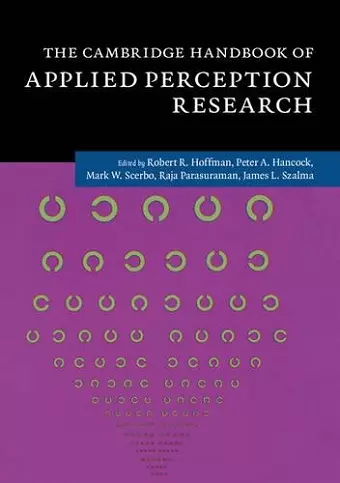The Cambridge Handbook of Applied Perception Research 2 Volume Hardback Set
Raja Parasuraman editor Robert R Hoffman editor Peter A Hancock editor Mark W Scerbo editor James L Szalma editor
Format:Set / collection
Publisher:Cambridge University Press
Published:26th Jan '15
Currently unavailable, and unfortunately no date known when it will be back

Focusing on everything from basic research practices to cutting-edge technology, this book is essential for student learning and professional research.
The Cambridge Handbook of Applied Perception Research covers core areas of research in perception with an emphasis on its application to real-world environments. Topics include multisensory processing of information, time perception, sustained attention, and signal detection, as well as pedagogical issues surrounding the training of applied perception researchers. In addition to familiar topics, such as perceptual learning, the Handbook focuses on emerging areas of importance, such as human-robot coordination, haptic interfaces, and issues facing societies in the twenty-first century (such as terrorism and threat detection, medical errors, and the broader implications of automation). Organized into sections representing major areas of theoretical and practical importance for the application of perception psychology to human performance and the design and operation of human-technology interdependence, it also addresses the challenges to basic research, including the problem of quantifying information, defining cognitive resources, and theoretical advances in the nature of attention and perceptual processes.
'A comprehensive review of current research by the top-tier authors in the field, with wide application to human-system integration.' Thomas Sheridan, Professor Emeritus of Applied Psychology, Massachusetts Institute of Technology
'A handbook of applied perception research is a challenging undertaking. This one meets the challenge with 54 chapters authored by an impressive array of experts, spanning multiple sensory modalities, diverse methodologies, processes ranging from sensory to emotional, individual variation along with norms - and all of these from a basic and applied perspective. Among the welcome expansions on traditional topics like ergonomics and attention are chapters on the modalities of touch and olfaction, human-robot interaction, effects of video-game play, ecological approaches, and development across the life span. Each chapter offers a concise introduction that will send the interested reader further, and the 1100+ pages as a whole provide an exciting and comprehensive portrait of this rapidly evolving field.' Roberta Klatzky, Carnegie Mellon University, Pennsylvania
'The Cambridge Handbook of Applied Perception Research is not just for perception researchers - it is the comprehensive resource on perception that all practitioners and researchers who hope to make an applied contribution have been waiting for.' Frank Durso, Georgia Institute of Technology
'This stimulating collection dramatically illustrates the breadth of applied perception research: from the effects of video-game play on visual attention to the possibilities of olfactory interfaces. The book is also a testimony to the enduring impact of Joel Warm on the study of vigilance in particular and applied perception research in general.' Jeremy Wolfe, Brigham and Women's Hospital, Harvard Medical School
'The Cambridge Handbook of Applied Perception Research weaves stories of the challenges faced by application-inspired researchers into the fabric of today's core disciplinary ideas. Contributors note that the story of applied perception research is the story of experimental psychology more broadly, and many of the chapters in this volume provide evidence that this claim has merit. Forward-looking chapters also show how questions posed in the context of emerging applications, such as human-robot coordination, virtual environments, and security management, might provide direction for both experimental psychology and cognitive science in the years to come.' C. Melody Carswell, Associate Director, Center for Visualization and Virtual Environments, University of Kentucky
'… an exciting and comprehensive assessment of developments in experimental psychology and the role perception plays in human-system engineering. The Handbook represents an extraordinary achievement with 54 expert chapters covering every sensory modality, methodologies, and applications … Tapping on what is known in perceptual research and applying this knowledge to understand behavior and performance in working environments is the real challenge this work has managed to address so well … The Handbook is a unique, comprehensive resource on application-inspired research in perception that will benefit many researchers and practitioners involved in the ever increasing number of emerging applications.' John L. Barbur, Perception
'The high complexity and importance of this work may be understood considering the vital fields implicated herein, such as, for instance, brain and its mechanism, cognitive processes, memory, attention, senses, biological substrates and processes; as well as the interrelation between the latter elements. The large number (ca. 100) of pioneer contributors to the work at hand reflects its great impact. This handbook constitutes a milestone in the field of applied perception. Its main target group refers to perception scientists and -generally speaking- to psychologists. Moreover, it is of great importance for computer scientists as well as for applications engineers; finally, for signal or/and sensor scientists/engineers.' Nikolaos E. Myridis, Contemporary Physics
ISBN: 9781107096400
Dimensions: 254mm x 182mm x 70mm
Weight: 2410g
1150 pages